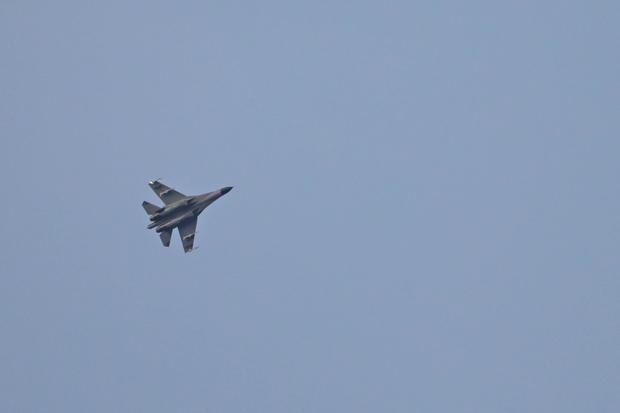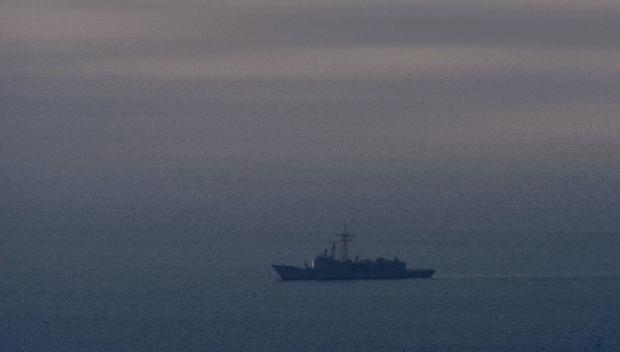Beijing — China carried out fresh military drills around Taiwan Monday, Beijing said, defying calls to end its largest-ever exercises encircling the island in the wake of a visit by U.S. House Speaker Nancy Pelosi. Beijing has raged at the trip by Pelosi — the highest-ranking elected U.S. official to visit Taiwan in decades.
The visit, which Beijing warned against for weeks, prompted China to tear up a series of talks and cooperation agreements with Washington, most notably on climate change and defense. It has also deployed fighter jets, warships and ballistic missiles in what analysts have described as practice for a blockade and ultimate invasion of the self-ruled democratic island that China claims as its territory. Those drills had been expected to draw to a close on Sunday, but China said Monday they were still ongoing.
“The eastern theater of the Chinese People’s Liberation Army continued to carry out practical joint exercises and training in the sea and airspace around Taiwan island,” the military said.
The exercises, the PLA’s Eastern Command said, were “focusing on organizing joint anti-submarine and sea assault operations.”
Taipei condemned Beijing for extending the drills. “China’s provocation and aggression have harmed the status quo of the Taiwan Strait and raised tensions in the region,” the island’s foreign ministry said in a statement. Beijing was also set to carry out live-fire drills on Monday in parts of the South China Sea and the Yellow Sea. Taiwan has remained defiant throughout the Chinese drills. Its military said it would hold anti-landing exercises in Taiwan’s south on Tuesday and Thursday.
“We will practice counter moves against simulated enemy attacks on Taiwan,” Lou Woei-jye, spokesman for Taiwan’s Eighth Army Corps, told AFP.
They will include the deployment of hundreds of troops and about 40 howitzer guns, the military said. Taiwan has insisted that no Chinese planes or ships have entered Taiwan’s territorial waters during the drills. But to show how close it came to Taiwan’s shores, the Chinese military released a video of an air force pilot filming the island’s coastline and mountains from his cockpit.
The Eastern Command also shared a photo it said was of a warship on patrol with Taiwan’s shoreline visible in the background. Ballistic missiles were fired over Taiwan’s capital during the exercises last week, according to Chinese state media.
The scale and intensity of China’s drills — as well as its withdrawal from key talks on climate and defense — have triggered outrage in the United States and other democracies. U.S. Secretary of State Antony Blinken has said Washington is “determined to act responsibly” to avoid a major global crisis. But Beijing on Monday defended its behavior as a “firm, forceful and appropriate” response to what it considers American provocation. “(We) are only issuing a warning to the perpetrators,” foreign ministry spokesman Wang Wenbin said during a regular briefing, promising China would “firmly smash the Taiwan authorities’ illusion of gaining independence through the U.S.”
“We urge the U.S. to do some earnest reflection, and immediately correct its mistakes,” he said.
Speaking to CBS News’ “Face the Nation” on Sunday in Washington, Taiwan’s top representative to the U.S., Bi-khim Hsiao, said it was not her island nor the U.S. doing the threatening.
“We have been living under the threat from China for decades,” she told moderator Margaret Brennan. “We cannot let their ongoing threats define our desire to make friends internationally. If you have a kid being bullied at school, you don’t say you don’t go to school. You try to find a way to deal with the bully, and that’s exactly what Taiwan is doing, and working on making our society stronger and more resilient, fortifying our defenses so, so that we have means of managing risks. The risks are not posed by Taiwan, nor are they posed by the United States. The risks are posed by Beijing.” Experts say the drills have revealed an increasingly emboldened Chinese military capable of carrying out a grueling blockade of the island and obstructing any U.S. forces that might try to come to Taiwan’s aid. “In some areas, the PLA might even surpass U.S. capabilities,” Grant Newsham, a researcher at the Japan Forum for Strategic Studies and a former U.S. Navy officer, told AFP. “If the battle is confined to the area right around Taiwan, today’s Chinese navy is a dangerous opponent — and if the Americans and Japanese do not intervene for some reason, things would be difficult for Taiwan.”
This article was first published in CBS News . All contents and images are copyright to their respective owners and sources.













